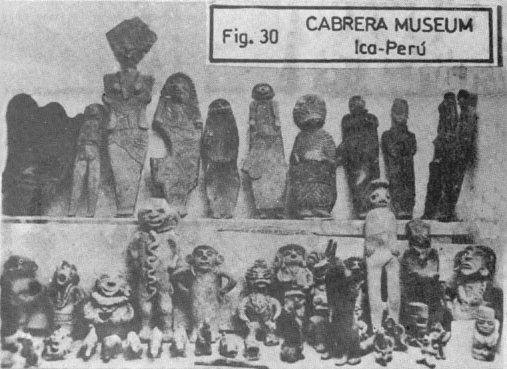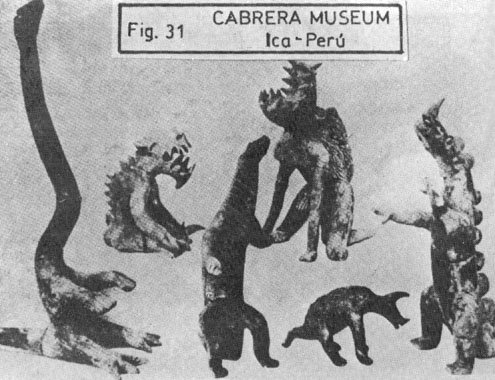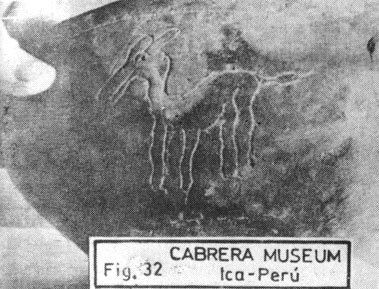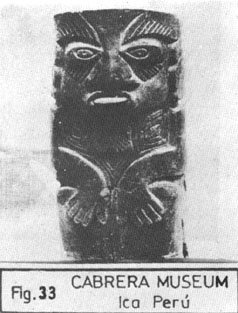(this material is an excerpt from the book
"The Message of the Stones", by Dr. Javier Cabrera)
(EXCERPT #3C)
THE MYSTERY OF ACAMBARO
The North American scientist Charles H. Hapgood, a dedicated archeologist, revealed in
1973 the results of his laborious study of an extraordinary collection of 32,000
artifacts, the property of the German collector Waldemar Julsrud. The collection is
composed of ceramics, carved wooden objects, and engraved stones all from the region
around Acambaro, in central Mexico (15). Looking at the color reproductions of many of
these objects, one notes that the images of human beings do not resemble the inhabitants
of the region in particular or the American Indian in general; and the animal images seem
to be fantastic, though some species of extinct animals can be discerned. We see oriental,
negroid, and Aryan human types, and we see, among the identifiable prehistoric animals,
anthropoids, anteaters, crabs, horses, camels, crocodiles, and various species of
dinosaur, including the stegasaurus, corinthosaurus, tyranosaurus, plesiosaurus,
brontosaurus, and pelicosaurus (Fig. 30, 31, 32, and 33).

FIGURES 30, 31, 32, 33: Part of
the 32,000 pieces found in Acambaro, Mexico, from the collection of Waldemar
Julsrud,
studied by Charles H. Hapgood. They provide further proof of cultural
mestizaje, the blending of gliptolithic culture with the
cultures of the recent
past. FIGURE 30: Human figures made of clay that do not resemble Men of the
Western hemisphere.

FIGURE 31: Prehistoric animals
carved in clay.


FIGURE 32: An
engraved stone. FIGURE 33: Human figure carved in wood. Photos from Mystery in Acambaro by H. Hapgood.
For over twenty years archeologists thought these pieces were fakes. In support of this
hypothesis they pointed out that 1) never before had so many pieces been found in so small
an area; 2) never before had such delicate and fragile objects been preserved underground
in such pristine condition; 3) the objects made reference to unknown cultures; 4) the absence of
patina and the accumulation of saltpeter was inexplicable, and 5) the depiction of
dinosaurs was further proof that the etchings were phony. The suggestion that the pieces
were of recent manufacture, and that the person who manufactured them was Odilon Tinajero,
a resident of Acambaro, who had sold specimens to the collection with the assurance that
they were unearthed by him and his family. But doubts remained: the collection contained
pieces that demonstrated considerable knowledge on some themes, such as the customs and
legends of the Indian people, and rare and exotic extinct animals; many also showed
extraordinary artistic ability. But Odilon Tinajero scarcely knew how to read and write
and like the rest of his family had never exhibited any talent for things artistic.
Hapgood enlisted the services of a famous expert in the detection of falsifications. It
had already been established that the pieces had been fired in an open oven, and given the
sheer quantity of pieces that existed, this oven would have had to have been kept going
day and night over a long period of time which would in turn have required copious
firewood. The investigations carried out by the expert, the municipal authorities, and by
a local professor, however, conclude that: 1) Odilon Tinajero did not own an oven; 2) no
one had seen smoke that might reveal the functioning of such an oven, and 3) there was not
wood sufficient in the area to permit the firing of the thousands of specimens. Beyond this, Odilon Tinajero was selling the pieces at a price which would not have covered the
investment needed to fabricate them. Hapgood turned to laboratory analysis in order to try
to verify the age of the pieces. The analysis - using radiocarbon dating and the
thermoluminescent method - certified that the pieces were old. The first method gave an
age of 6,400 to 3,500 years, and the second, for some pieces, an age of 4,500 years. Thus
was Hapgood able to demonstrate the archeological value of this incredible collection,
ending a long period of doubt and incredulity.
Among Hapgood's conclusions is the notion that the extinct animals and the age of
the pieces suggest that the culture of Acambaro predates all others known in America, and
that Acambaro culture had an influence on all later cultures. He also thinks that they nay
have had a cult of reptiles, evidence of which appears in the collection. He does not
argue for the coexistence of extinct animals and man in Acambaro. On this point Hapgood is
correct: I think that on the basis of this collection the coexistence of prehistoric
animals and the makers of the pieces cannot be postulated and that in all probability the
age of the pieces is not greater than that given out in the laboratory report. I believe
that this collection provides still more proof of cultural mestizaje between the artifacts
of the gliptolithic era and the era of Acambaro man. Acambaro man must have had an oral
tradition, and by way of his ancestors he heard of a world in which both man and
prehistoric animals lived. This information was probably obtained by his ancestors through
some gliptolithic objects, although it is possible that the information was imparted
directly from generation to generation since, as we saw in Chapter One, while the splendor
of the gliptolithic humanity came to an end, the human genus did not. The cultural
mestizaje seen in the pieces from Acambaro can be seen in the alteration of the true
morphologies of some men and animals, through the particular filter of the men who created
the objects.
-----------------------
Footnotes:
(15) Charles H. Hapgood: Mystery in Acambaro. An account of the ceramic collection of the
late Waldemar Julsrud in Acambaro, GTO., Mexico. Printed by Griswold Offset Printing, Inc.
Brattlebaro, Vermont 1973.
BACK TO EXCERPT INDEX